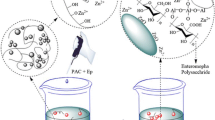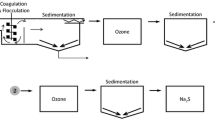Abstract
A new inorganic-organic hybrid material zirconium-glycine complex (ZGC) was firstly used as a coagulant in a coagulation process to treat Pearl River raw water. Its coagulation performance was compared with commonly used aluminum (Al) coagulants such as aluminum sulfate (Al2(SO4)3) and polyaluminum chloride (PAC), in terms of water quality parameters and floc properties. ZGC coagulation achieved higher removal of turbidity (93.8 %) than other traditional coagulants. Charge neutralization was proven to act as a dominant mechanism during ZGC coagulation. The aggregated flocs with ZGC showed the fastest growth rate and good recovery ability compared with the other coagulants and achieved the largest floc size within 5 min. The ZGC coagulant can decrease the hydraulic retention time and increase removal efficiency.






Similar content being viewed by others
References
Ayukawa B (1978) Method for purification of waste water by treatment with zirconium salt. US Patent 4(066):542
Bache DH (2004) Floc rupture and turbulence: a framework for analysis. Chem Eng Sci 59:2521–2534
Boller M, Blaser S (1998) Particles under stress. Water Sci Technol 37:9–29
Chen T, Gao B, Yue Q (2009) Effect of dosing method and pH on color removal performance and floc aggregation of polyferric chloride-polyamine dual-coagulant in synthetic dyeing wastewater treatment. Colloid Surf A 355:121–129
Clearfield A (1990) The mechanism of hydrolytic polymerization of zirconyl solutions. J Mater Res 5:161–162
Dentel SK (1988) Application of the precipitation-charge neutralization model of coagulation. Environ Sci Technol 22:825–832
Divakaran R, Pillai NS (2001) Flocculation of kaolinite suspension in water by chitosan. Water Res 35:3904–3908
Duan JM, Gregory J (2003) Coagulation by hydrolysing metal salts. Adv Colloid Interface Sci 100:475–502
Gregory J, Nelson DW (1986) Monitoring of aggregates in flowing suspensions. Colloid Surf 18:175–185
Hu C, Liu H, Qu J et al (2006) Coagulation behavior of aluminum salts in eutrophic water: significance of Al13 species and pH control. Environ Sci Technol 40:325–331
Jarvis A, Jefferson B, Gregory J, Parsons SA (2005) A review of floc strength and breakage. Water Res 39:3121–3137
Jarvis P, Banks J, Molinder R et al (2008) Processes for enhanced NOM removal: beyond Fe and Al coagulation. Water Sci Technol Water Supply 8:709–716
Jarvis P, Sharp E, Pidou M et al (2012) Comparison of coagulation performance and floc properties using a novel zirconium coagulant against traditional ferric and alum coagulants. Water Res 46:4179–4187
Kroschwitz JI, Howe-Grant M (1999) Zirconium and zirconium compounds. Wiley, New York
Lakshmanan D, Clifford D, Samanta G (2008) Arsenic removal by coagulation with aluminum, iron, titanium, and zirconium. J Am Water Works Assoc 100:76–88
Landen K (1999) Antiperspirants and deodorants. CRC, New York
Lee KE, Morad N, Teng TT et al (2012) Development, characterization and the application of hybrid materials in coagulation/flocculation of wastewater: a review. Chem Eng J 203:370–386
Letterman RD, Iyer DR (1985) Modelling the effects of hydrolysed aluminum and solution chemistry on flocculation kinetics. Environ Sci Technol 19:673–681
Li Z, Zhong S, Lei HY et al (2009) Production of a novel bioflocculant by Bacillus licheniformis X14 and its application to low temperature drinking water treatment. Bioresour Technol 100:3650–3656
Mekhamer WK, Assaad FF (1999) Flocculation and coagulation of Ca- and K-saturated montmorillonite in the presence of polyethylene oxide. J Appl Polym Sci 73:659–662
Ott R, Kramer R (1998) Rapid phosphodiester hydrolysis by zirconium (IV). Angew Chem Int Edit 37:1957–1960
Pan L, Heddy R, Li J, Zheng C et al (2008) Synthesis and structural determination of a hexanuclear zirconium glycine compound formed in aqueous solution. Inorg Chem 47:5537–5539
Pappas I, Fitzgerald M, Huang XY et al (2009) Thermally resolved in situ dynamic light scattering studies of zirconium(IV) complex formation. Cryst Growth Des 9:5213–5219
Rong HY, Gao BY, Dong M et al (2013) Characterization of size, strength and structure of aluminum-polymer dual-coagulant flocs under different pH and hydraulic conditions. J Hazard Mater 252:330–337
Rose J, De Bruin TJM, Chauveteau G et al (2003) Aqueous zirconium complexes for gelling polymers. A combined X-ray absorption spectroscopy and quantum mechanical study. J Phys Chem B 107:2910–2920
Shih IL, Van YT, Yeh LC et al (2001) Production of a biopolymer flocculant from Bacillus licheniformis and its flocculation properties. Bioresour Technol 78:267–272
Shin JY, Spinette RF, O’Melia CR (2008) Stoichiometry of coagulation revisited. Environ Sci Technol 42:2582–2589
Snodgrass WJ, Clark MM, O’Melia CR (1984) Particle formation and growth in dilute aluminum (III) solutions. Water Res 18:479–488
Thomas DN, Judd SJ, Fawcett N (1999) Flocculation modelling: a review. Water Res 33:1579–1592
Wang Y, Gao BY, Yue QY et al (2006) Novel composite flocculent polyferric chloride-polydimethyldiallylammonium chloride (PFC-PDADMAC): its characterization and flocculation efficiency. Water Pract Technol 1:1–9
Xiao F, Ma J, Yi P, Huang J (2008) Effects of low temperature on coagulation of kaolinite suspensions. Water Res 42:2983–2992
Yao HB, Yan YX, Gao HL et al (2011) An investigation of zirconium(IV)-glycine(CP-2) hybrid complex in bovine serum albumin protein matrix under varying conditions. J Mater Chem 21:19005–19012
Yukselen MA, Gregory J (2004) The reversibility of floc breakage. Int J Miner Process 73:251–259
Zhao YX, Gao BY, Cao BC et al (2011) Comparison of coagulation behavior and floc characteristics of titanium tetrachloride (TiCl4) and polyaluminum chloride (PACl) with surface water treatment. Chem Eng J 166:544–550
Zhao S, Gao BY, Yue QY et al (2013) Effect of Enteromorpha extract on characteristics of flocs formed by aluminum sulfate in Yellow River water treatment under different hydraulic conditions. Chem Eng J 215–216:358–365
Acknowledgements
This study was financially supported by the National Nature Science Foundation of China (Nos. 51078148 and 41173103).
Author information
Authors and Affiliations
Corresponding author
Additional information
Responsible editor: Angeles Blanco
Rights and permissions
About this article
Cite this article
Zhang, Z., Wu, C., Wu, Y. et al. Comparison of coagulation performance and floc properties of a novel zirconium-glycine complex coagulant with traditional coagulants. Environ Sci Pollut Res 21, 6632–6639 (2014). https://doi.org/10.1007/s11356-014-2575-7
Received:
Accepted:
Published:
Issue Date:
DOI: https://doi.org/10.1007/s11356-014-2575-7




